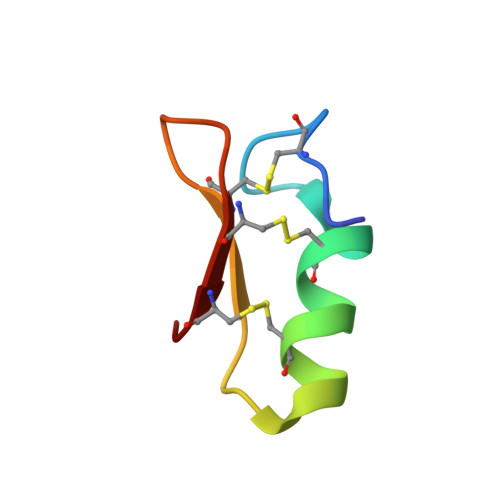Weaponisation 'on the fly': Convergent recruitment of knottin and defensin peptide scaffolds into the venom of predatory assassin flies.
Jin, J., Agwa, A.J., Szanto, T.G., Csoti, A., Panyi, G., Schroeder, C.I., Walker, A.A., King, G.F.(2019) Insect Biochem Mol Biol 118: 103310-103310
- PubMed: 31870846
- DOI: https://doi.org/10.1016/j.ibmb.2019.103310
- Primary Citation of Related Structures:
6PX7, 6PX8 - PubMed Abstract:
Many arthropod venom peptides have potential as bioinsecticides, drug leads, and pharmacological tools due to their specific neuromodulatory functions. Assassin flies (Asilidae) are a family of predaceous dipterans that produce a unique and complex peptide-rich venom for killing insect prey and deterring predators. However, very little is known about the structure and function of their venom peptides. We therefore used an E. coli periplasmic expression system to express four disulfide-rich peptides that we previously reported to exist in venom of the giant assassin fly Dolopus genitalis. After purification, each recombinant peptide eluted from a C18 column at a position closely matching its natural counterpart, strongly suggesting adoption of the native tertiary fold. Injection of purified recombinant peptides into blowflies (Lucilia cuprina) and crickets (Acheta domestica) revealed that two of the four recombinant peptides, named rDg3b and rDg12, inhibited escape behaviour in a manner that was rapid in onset (<1 min) and reversible. Homonuclear NMR solution structures revealed that rDg3b and rDg12 adopt cystine-stabilised α/ß defensin and inhibitor cystine knot folds, respectively. Although the closest known homologues of rDg3b at the level of primary structure are dipteran antimicrobial peptides such as sapecin and lucifensin, a DALI search showed that the tertiary structure of rDg3b most closely resembles the K V 11.1-specific α-potassium channel toxin CnErg1 from venom of the scorpion Centruroides noxius. This is mainly due to the deletion of a large, unstructured loop between the first and second cysteine residues present in Dg3b homologues from non-asiloid, but not existing in asiloid, species. Patch-clamp electrophysiology experiments revealed that rDg3b shifts the voltage-dependence of K V 11.1 channel activation to more depolarised potentials, but has no effect on K V 1.3, K V 2.1, K V 10.1, K Ca 1.1, or the Drosophila Shaker channel. Although rDg12 shares the inhibitor cystine knot structure of many gating modifier toxins, rDg12 did not affect any of these K V channel subtypes. Our results demonstrate that multiple disulfide-rich peptide scaffolds have been convergently recruited into asilid and other animal venoms, and they provide insight into the molecular evolution accompanying their weaponisation.
Organizational Affiliation:
Institute for Molecular Bioscience, The University of Queensland, St Lucia, QLD, 4072, Australia.














